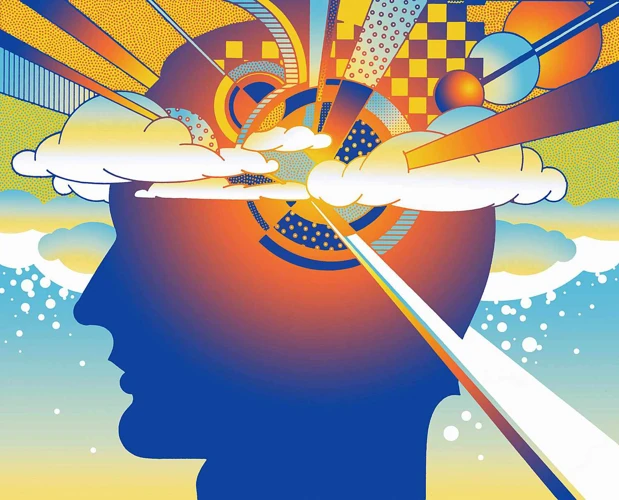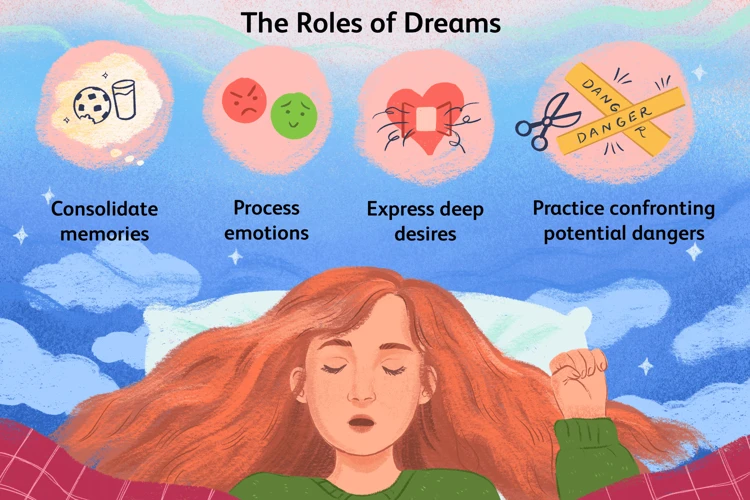Imagine a world where reality intertwines with the mysterious realm of dreams, where symbols hold the key to unlocking hidden meanings and uncovering the depths of our psyche. Step into the captivating realm of symbolic dreams, where the subconscious mind communicates through vivid imagery and enigmatic symbols. In this article, we delve into the fascinating world of symbolic dreams, exploring their importance, interpretation, and types. We also uncover the psychological, cultural, and spiritual contexts that influence these dreams, and how they can be used for personal growth and self-discovery. Join us on this journey of exploration as we unravel the perplexing language of dreams and delve into the realms of the unconscious mind.
What are Symbolic Dreams?

Symbolic dreams are a type of dream in which the subconscious mind communicates through the use of symbols. These dreams are filled with vivid imagery and enigmatic representations that hold deeper meanings beyond their surface appearance. Symbols can take many forms, including objects, animals, people, or even abstract concepts. Each symbol carries its own unique significance, which may vary depending on the individual’s personal experiences and cultural background. What sets symbolic dreams apart is their ability to convey messages and insights that may not be readily apparent in everyday life. These dreams often tap into the unconscious mind’s rich tapestry of symbols, archetypes, and metaphors, allowing for a profound exploration of the self and the hidden aspects of our psyches. By understanding and deciphering the symbolism within these dreams, we can gain valuable insights into our emotions, desires, fears, and unconscious patterns. Symbolic dreams offer a doorway into the depths of our psyche, inviting us to embark on a journey of self-discovery and personal growth. To explore more about other fascinating dream experiences, you can read about sleep paralysis dreams, prophetic dreams, or recurring dreams.
The Importance of Symbolism in Dreams

Symbolism plays a crucial role in dreams, as it allows the subconscious mind to communicate complex ideas and emotions in a condensed and symbolic form. The use of symbols in dreams allows for the expression of abstract concepts or hidden desires that may be difficult to convey through straightforward language. Symbolic dreams enable individuals to tap into their innermost thoughts and feelings, providing insights into their unconscious motivations and conflicts. By deciphering the symbolism within their dreams, individuals can gain a deeper understanding of themselves and their experiences. Symbols can carry personal meanings that are unique to individuals based on their own life experiences and cultural backgrounds. They can also tap into universal archetypes and collective symbols that resonate with a broader human experience. The importance of symbolism in dreams lies in its ability to bridge the gap between the conscious and unconscious mind, offering a glimpse into the profound depths of the psyche. It provides a powerful tool for self-exploration, personal growth, and the integration of unconscious aspects of the self into conscious awareness.
The Interpretation of Symbolic Dreams

The interpretation of symbolic dreams is a complex and intricate process that requires an understanding of the unique symbols and personal associations that exist within each individual’s dream world. One approach to interpreting these dreams is to consider the universal meanings and associations that certain symbols may hold across cultures and psychological frameworks. For example, water often represents emotions and the subconscious, while falling can symbolize a lack of control or feeling overwhelmed. However, it is crucial to recognize that personal symbolism plays a significant role in dream interpretation as well. Each person may have their own unique set of symbols and associations based on their individual experiences, memories, and cultural background. To uncover the true meaning of a symbolic dream, the dreamer must engage in a process of self-reflection and exploration. Keeping a dream journal, analyzing recurring symbols, and consulting reputable dream dictionaries or resources can provide insights and guidance. Ultimately, the interpretation of symbolic dreams is a deeply personal and subjective endeavor that requires introspection and an open mind.
Understanding Common Symbols
Understanding common symbols is essential in unraveling the mysteries hidden within symbolic dreams. These symbols can vary across cultures and individuals, but there are some universal symbols that frequently appear in dreams. Here are some common symbols and their potential meanings:
- Water: Water often represents emotions, purity, and the subconscious mind. It can signify feelings of calmness, clarity, or a need for emotional healing.
- Snakes: Snakes are often associated with transformation, healing, and sexuality. They can represent hidden fears, desires, or a need for change and personal growth.
- Flight: Flying in dreams typically symbolizes freedom, transcendence, and the ability to rise above challenges. It may indicate a desire for liberation or a longing for escape from life’s burdens.
- Doors: Doors in dreams can represent new opportunities, transitions, or the opening of possibilities. They may also reflect a sense of confinement or the need to make important choices.
- Mirror: Mirrors often symbolize self-reflection, self-perception, and how one presents themselves to the world. They can signify a need for introspection, self-awareness, or a desire to understand oneself better.
- Animals: Animals in dreams often carry symbolic meanings. For example, a wolf can represent inner strength and instincts, while a dove can symbolize peace and harmony.
- Numbers: Numbers can hold significant meaning in dreams. For instance, the number three is often associated with creativity, harmony, and spiritual completeness.
It is important to remember that these interpretations may vary depending on the context of the dream and the personal associations each individual holds with these symbols. Keeping a dream journal and reflecting on the emotions and experiences tied to these symbols can help in unraveling their specific meanings for you personally.
Personal Symbolism
Personal symbolism in dreams refers to the unique set of symbols and meanings that hold significance to an individual based on their personal experiences, beliefs, and emotions. These symbols can vary greatly from person to person and may not have universally recognized meanings. For example, while a butterfly might generally be associated with transformation or freedom, to someone who had a specific personal encounter with a butterfly that holds deep emotional significance, it may represent something entirely different. This personal symbolism is deeply rooted in the individual’s subconscious mind, drawing upon their memories, associations, and innermost desires. To uncover the personal symbolism within a dream, it is important to reflect on the context of the symbol and the emotions it evokes. Keeping a dream journal can be immensely helpful in identifying patterns and recurring symbols that hold personal significance. By developing an understanding of one’s own personal symbolism, one can gain valuable insights into their inner world and make connections between their dreams and waking life experiences.
Types of Symbolic Dreams

Symbolic dreams come in various forms, each offering a unique experience and a different level of consciousness. Understanding the different types of symbolic dreams can provide further insight into their nature and significance. One type of symbolic dream is the recurring dream, where the same dream or elements of it repeat over time. These dreams often hold unresolved emotions or recurring themes that require attention and exploration. Another type is the lucid dream, where the dreamer becomes aware that they are dreaming and can actively participate and manipulate the dream content. Lucid symbolic dreams open up possibilities for self-guided exploration and problem-solving within the dream state. Prophetic dreams are yet another type, where individuals receive messages or glimpses of future events through symbolic imagery. These dreams offer a profound connection to intuition and potential foresight. Each type of symbolic dream provides a unique lens through which we can understand ourselves, our subconscious mind, and the greater mysteries of the dream realm.
Recurring Symbolic Dreams
Recurring symbolic dreams are a fascinating phenomenon that occurs when the same or similar symbols, themes, or scenarios repeat themselves in a person’s dream experiences over time. These dreams tend to leave a lasting impression, as they often carry a sense of familiarity or significance. It’s believed that recurring symbolic dreams serve as important messages from the subconscious mind, highlighting unresolved issues, patterns, or emotions that require attention or reflection.
One possible explanation for recurring symbolic dreams is that they reflect recurring patterns or challenges in a person’s waking life. These dreams act as a mirror, urging the dreamer to pay closer attention to certain aspects of their life that may need adjustment or resolution. For example, a person who frequently dreams about being chased may be experiencing deep-seated fear or anxiety in their waking life that needs to be confronted.
Another perspective suggests that recurring symbolic dreams may be influenced by the individual’s psychological archetypes or collective unconscious. These archetypes, as described by psychologist Carl Jung, represent universal patterns and themes that are shared among all individuals. The repetition of certain symbols or themes in dreams may be a manifestation of these archetypal energies, inviting the dreamer to explore and integrate aspects of their own psyche.
To better understand recurring symbolic dreams, it can be helpful to keep a dream journal and document the details of each dream, noting any recurring symbols or themes. By identifying patterns and commonalities among these dreams, the dreamer may gain valuable insights into their own subconscious mind and the messages it wishes to convey. Exploring the symbolism and personal significance attached to these recurring dreams can provide profound self-reflection and an opportunity for personal growth.
Lucid Symbolic Dreams
Lucid symbolic dreams add an extra layer of intrigue and possibility to the world of dreams. In these dreams, the dreamer becomes aware that they are dreaming while still in the dream state. This awareness allows the dreamer to have a degree of control and influence over the dream narrative. In the context of symbolic dreams, lucidity provides a unique opportunity to actively engage with the symbols and explore their deeper meanings. Dreamers can consciously interact with the symbols, ask them questions, and even manipulate them to gain further insights. This heightened state of awareness in lucid dreams enables individuals to delve into the depths of their own psyche and unravel the symbolism on a more profound level. It offers a chance to experiment with different interpretations, test assumptions, and gain a deeper understanding of oneself. Lucid symbolic dreams can be a powerful tool for personal growth and self-exploration, providing a unique playground for the conscious mind to engage with the subconscious. The ability to experience lucid dreams can be enhanced through various techniques such as reality checks, maintaining dream journals, and practicing meditation or mindfulness. Embracing lucidity in symbolic dreams opens up a whole new dimension of exploration and self-discovery.
Prophetic Symbolic Dreams
Prophetic symbolic dreams are a fascinating phenomenon in which individuals experience dreams that seemingly provide glimpses into the future. These dreams are characterized by their symbolic nature, using vivid and potent imagery to convey messages about events or situations that have not yet occurred. People who have experienced prophetic symbolic dreams often report a sense of heightened intuition and a deep connection to their subconscious mind during these episodes. While the exact mechanism behind prophetic dreams remains a mystery, some theories suggest that these dreams may tap into the collective unconscious or access information beyond our conscious awareness. The symbols within these dreams may hold specific meanings and can be interpreted as signs or warnings of future events. It is essential to approach prophetic symbolic dreams with open-mindedness and discernment, as not every dream will have prophetic significance. However, for those who have experienced prophetic dreams, they can be a source of guidance, insight, and preparation for what lies ahead. Exploring the rich symbolism within these dreams and reflecting on their potential connections to real-world events can offer a profound sense of awe and wonder about the mysteries of the human mind and the nature of time itself.
How to Analyze Symbolic Dreams

Analyzing symbolic dreams requires a systematic approach to unravel the hidden meanings and messages they hold. The first step is to record your dreams as soon as you wake up, capturing as many details as possible. By keeping a dream journal, you create a valuable resource for identifying patterns and themes that recur in your dreams. Look for common symbols that appear frequently and explore their personal significance. Consulting dream dictionaries and resources can provide additional insights into the symbolism of certain objects or scenarios. However, it’s important to remember that symbolism is deeply personal, and individual interpretations may vary. To truly understand the meaning of your symbolic dreams, it’s crucial to reflect on your own emotions, experiences, and subconscious associations. Developing a deeper connection with your dreams and honing your intuition will help you unlock the layers of symbolism within them. Through this process of analysis, you can gain profound self-awareness and access the wisdom of your unconscious mind.
Recording Your Dreams
Recording your dreams is an essential step in analyzing and understanding the symbolism within them. By capturing the details of your dreams, you can create a valuable resource for future analysis. Here are some strategies to help you effectively record your dreams:
- Keep a dream journal: Dedicate a notebook or use a digital journal to write down your dreams as soon as you wake up. Capture as many details as possible, including the storyline, characters, emotions, and any symbols or objects that stand out.
- Date and categorize your dreams: Make sure to date each entry to track patterns and trends over time. You can also create categories based on themes or symbols that frequently appear in your dreams. This categorization can provide insights into recurring symbols or issues you may be working through.
- Use keywords and bullet points: To quickly jot down your dreams, use keywords, bullet points, or abbreviations. Focus on capturing the essence of the dream rather than writing a detailed narrative.
- Record your emotions: Note the emotions you experienced during the dream and upon waking up. Emotions can provide important clues about the meaning and significance of a dream.
- Draw or sketch: If you are visually inclined, consider incorporating drawings or sketches into your dream journal. Visual representations can offer additional layers of insight and help you remember key symbols or scenes.
- Maintain consistency: Make it a habit to record your dreams regularly, even if they seem insignificant. Dreams can be fleeting, so capturing them as soon as possible after waking increases accuracy and detail.
By consistently recording your dreams, you create a comprehensive dream journal that serves as a valuable resource for interpretation and analysis. The act of writing down your dreams also reinforces your intention to pay attention to them, leading to improved dream recall over time. Take the first step in decoding the mysteries of your dreams by recording them diligently.
Identifying Patterns and Themes
Identifying patterns and themes in symbolic dreams is a crucial step in unlocking their deeper meanings. Paying close attention to recurring symbols, emotions, and narrative elements can provide valuable insights into the underlying messages and themes within the dream. One way to identify patterns is to keep a dream journal and record your dreams as soon as you wake up. This allows you to review your dreams over time and look for recurring symbols or themes that may emerge. Additionally, you can create a table or list to categorize and analyze different symbols and their associated meanings. For example, you could have columns for symbols, emotions, and actions, and then fill it in with the relevant information from your dreams. This visual representation can help you spot patterns and connections that may not be immediately apparent. It’s important to consider the context and personal associations of each symbol. While certain symbols may have universal meanings, their interpretation can also be influenced by individual experiences, cultural background, and personal beliefs. Reflecting on your own feelings and reactions to specific symbols can provide further insight into their personal significance. By identifying patterns and themes in symbolic dreams, you can unravel the intricate messages hidden within and gain a deeper understanding of your subconscious thoughts, emotions, and desires.
Consulting Dream Dictionaries and Resources
Consulting dream dictionaries and resources can be a helpful tool in analyzing and understanding the symbolism within your dreams. Dream dictionaries are collections of symbols and their associated interpretations, providing insight into the possible meanings behind different dream elements. These resources can serve as a starting point for deciphering the symbolism in your dreams, offering potential explanations and insights into the hidden messages they contain. However, it is important to approach dream dictionaries with caution as dream symbolism is highly subjective and can vary depending on personal experiences and cultural contexts. The meanings provided in dream dictionaries should be used as a guide rather than definitive interpretations. It is also beneficial to explore various dream resources, such as books, articles, and online forums, which offer different perspectives and insights into dream symbolism. Engaging in discussions with others who share an interest in dreams can provide additional interpretations and perspectives on your dreams. Ultimately, while dream dictionaries and resources can be helpful tools, it is important to remember that the interpretation of symbolic dreams is a deeply personal and intuitive process, and the true meaning of your dreams lies within your own unique experiences and associations.
The Psychology of Symbolic Dreams

The psychology of symbolic dreams delves into the fascinating relationship between the unconscious mind and the symbolic imagery that appears in our dreams. Symbolic dreams are believed to provide a window into the depths of our psyche, revealing hidden desires, fears, and unresolved conflicts. According to psychoanalytic theories, such as those proposed by Sigmund Freud, symbols in dreams serve as representations of repressed thoughts and emotions. These symbols can be highly personal, reflecting individual experiences and traumas unique to each person. Additionally, dream analysis often explores the concept of psychological archetypes, which are universal symbols and themes that have been passed down through generations. These archetypes, such as the mother, the hero, or the trickster, tap into universal human experiences and can carry profound meanings in symbolic dreams. By exploring the psychology of symbolic dreams, we can gain valuable insights into our unconscious mind, unraveling hidden aspects of ourselves and potentially facilitating personal growth and self-understanding.
Unconscious Mind and Symbolism
The unconscious mind plays a central role in the realm of symbolic dreams, as it is the wellspring from which symbolism emerges. Deep within our subconscious, lies a reservoir of memories, experiences, and emotions that are not easily accessible to our conscious awareness. Symbolism in dreams serves as a bridge between the conscious and unconscious realms, allowing the unconscious mind to communicate and express itself. Through symbolism, the unconscious mind can convey complex ideas, unresolved emotions, and unacknowledged desires. These symbols act as a kind of language, forming a rich tapestry of meaning that can be decoded and understood. The interpretation of symbolic dreams requires tapping into our intuition and accessing the deeper layers of our psyche. It involves exploring the personal associations and cultural significance attached to specific symbols. While certain symbols may have collective meanings, it is crucial to remember that the interpretation of symbolism is highly subjective and can vary from person to person. Engaging with the unconscious mind and embracing the language of symbolism can lead to profound self-discovery and a deeper understanding of ourselves.
Psychological Archetypes in Dreams
Psychological archetypes play a significant role in the realm of symbolic dreams. These archetypes represent universal patterns or themes that are deeply rooted in the collective unconscious, a concept introduced by renowned psychologist Carl Jung. Archetypes are fundamental symbols that appear in dreams across different cultures and time periods, transcending individual experiences. They are symbolic representations of fundamental human experiences, emotions, and desires. Some common archetypes that may appear in symbolic dreams include the Wise Old Man or Woman, representing wisdom and guidance; the Hero, symbolizing courage and transformation; the Shadow, representing repressed or hidden aspects of the self; and the Anima or Animus, representing the masculine or feminine aspects of one’s personality. These archetypes serve as a bridge between the conscious and unconscious mind, offering profound insights into our deepest fears, desires, and aspirations. By recognizing and engaging with these archetypes in our dreams, we can gain a better understanding of ourselves and navigate the complexities of our inner world. Embracing the archetypal energies within our dreams can lead to personal growth and integration of different aspects of our psyche.
The Cultural and Historical Context of Symbolic Dreams

Symbolic dreams have been of great significance throughout history, deeply ingrained in the cultural and historical contexts of various societies. Different cultures have embraced dreams as sources of wisdom, guidance, and even prophecy. In ancient civilizations such as the Egyptians and Greeks, dreams were believed to be messages from the divine. They were considered a means of communicating with gods and ancestors, often interpreted by priests or diviners. Many indigenous cultures around the world also hold strong beliefs in the spiritual and symbolic power of dreams, viewing them as a way to connect with the spirit world or receive messages from nature. Cultural symbols and mythologies play a crucial role in interpreting symbolic dreams, as symbols may hold different meanings within specific cultural contexts. Historical events and societal beliefs also shape the symbolism within dreams. For example, a dream featuring a snake may represent wisdom and rebirth in one culture, but symbolize treachery or danger in another. The cultural and historical context of symbolic dreams highlights the interconnectedness between dreams and human experiences, emphasizing the importance of considering these factors when interpreting the symbolism within our own dreams.
The Spiritual Significance of Symbolic Dreams

Symbolic dreams hold a profound spiritual significance, offering a gateway to a higher realm of consciousness and spiritual exploration. These dreams provide a unique opportunity for individuals to connect with their inner selves, tap into their intuition, and receive guidance from the spiritual realm. Symbols in these dreams often carry universal meanings that transcend cultural and personal boundaries, serving as a conduit for divine messages and spiritual enlightenment. Whether it is encountering spiritual beings, receiving prophetic visions, or experiencing transformative journeys, symbolic dreams can serve as powerful tools in deepening one’s spiritual connection. By embracing and deciphering the symbolic language of these dreams, individuals can access profound wisdom, gain clarity about their soul’s purpose, and embark on a path of self-discovery and spiritual growth. The spiritual significance of symbolic dreams invites us to explore the mystical dimensions of our existence, transcend our limitations, and embrace our spiritual potential.
Spiritual Symbols and Universal Meanings
Spiritual symbols hold a special place in the realm of symbolic dreams, as they often carry universal meanings that transcend cultural boundaries. These symbols have deep spiritual significance and can provide profound insights into our connection with the divine and the higher realms of existence. Here are some examples of spiritual symbols and their universal meanings:
1. **Cross:** The cross is a powerful symbol representing sacrifice, redemption, and spiritual transformation. It can symbolize both suffering and salvation, reminding us of the importance of faith and surrender.
2. **Lotus Flower:** The lotus flower is a symbol of enlightenment and spiritual purity. It represents the journey towards spiritual awakening and the ability to rise above the challenges and obstacles of life.
3. **Mandala:** The mandala is a geometric symbol that represents the universe and the interconnectedness of all things. It is often used as a tool for meditation and spiritual growth, symbolizing harmony, balance, and the eternal cycle of life.
4. **Infinity Symbol:** The infinity symbol, which resembles a sideways figure-eight, represents infinite possibilities, eternal love, and the interconnectedness of all things. It is a reminder of the infinite nature of the soul and the continuation of life beyond physical existence.
5. **Feather:** Feathers are often seen as symbols of spiritual guidance and protection. They represent the presence of angels, divine messengers, and are a reminder to trust in the higher powers that watch over us.
6. **Spiral:** The spiral is a symbol of growth, evolution, and the cyclical nature of life. It represents the journey of self-discovery and personal transformation, as we continuously spiral inward to uncover deeper layers of ourselves.
These are just a few examples of the countless spiritual symbols that may appear in symbolic dreams. It’s essential to remember that the interpretation of these symbols is highly personal and can vary based on individual experiences and beliefs. To unlock the deeper meanings of spiritual symbols in your dreams, it can be beneficial to reflect on your own spiritual journey and the emotions and sensations associated with the symbols.
Dreaming as a Path to Self-Discovery
Dreaming serves as a magnificent path for self-discovery. As we delve into the realm of dreams, we venture into the depths of our unconscious mind, unlocking hidden aspects of ourselves. Through dreaming, we gain insights into our fears, desires, and unresolved emotions. By paying attention to the symbolism and narratives woven within our dreams, we can unravel the mysteries of our subconscious and gain a deeper understanding of ourselves.
Dreaming offers a unique opportunity for self-reflection. It allows us to explore our inner landscape, bringing to light aspects of our personality that may be masked or unrecognized in our waking lives. Dreams often provide a safe space for us to confront and process unresolved conflicts or emotions, offering a healing and transformative experience.
To embark on the path of self-discovery through dreaming, it is important to cultivate a practice of dream journaling. Keeping a record of our dreams helps us recall and analyze their nuances and patterns. By writing down our dreams immediately upon waking, in as much detail as possible, we capture the essence of the dream and can revisit it later for deeper reflection.
It is also invaluable to pay attention to the emotions evoked in our dreams. Feelings experienced within the dream state can provide profound insights into our subconscious desires and fears. By exploring these emotions, we can gain a deeper understanding of ourselves and our inner motivations.
As we engage in self-reflection through our dreams, it is essential to approach them with an open and curious mindset. Symbolic dreams are not to be taken literally, but rather as invitations to explore the underlying meanings and messages they carry. It can be helpful to seek out resources such as dream dictionaries or engage in dream analysis with professionals who can provide valuable insights and interpretations.
Dreaming as a path to self-discovery empowers us to uncover hidden facets of our being, leading to personal growth and transformation. By embracing and exploring the wisdom of our dreams, we embark on a journey that allows us to connect with our authentic selves and navigate the intricate landscape of our inner world. It is through this process of self-discovery that we can cultivate a deeper sense of self-awareness and live more consciously in our waking lives.
Dreams and Personal Growth

Dreams have the power to shape and transform us, serving as a catalyst for personal growth and self-reflection. When we delve into the realm of symbolic dreams, we embark on a journey of inner exploration and discovery. These dreams can provide valuable insights into our deepest desires, fears, and unresolved emotions. By paying attention to the symbols and themes within our dreams, we can gain a deeper understanding of ourselves and our subconscious motivations. Symbolic dreams serve as a potent tool for self-reflection, allowing us to confront unresolved issues, heal emotional wounds, and gain clarity on our life’s path. Through interpreting and reflecting on our dreams, we can integrate the lessons and wisdom they offer into our daily lives, fostering personal growth and transformation. With each dream, we have the opportunity to gain new insights, expand our consciousness, and embark on a journey of self-discovery. The potential for personal growth through our dreams is limitless, as we tap into the vast resources of our inner selves and harness the power of the unconscious mind.
Using Symbolic Dreams for Self-Reflection
Using Symbolic Dreams for Self-Reflection can be a powerful tool for personal growth and self-discovery. When we pay attention to the symbols and themes present in our dreams, we gain valuable insight into our subconscious thoughts, emotions, and behaviors. Symbolic dreams often act as a mirror, reflecting aspects of ourselves that we may not be fully aware of in our waking lives. They can reveal our fears, desires, unresolved conflicts, and untapped potentials. To make the most of using symbolic dreams for self-reflection, it is important to develop a practice of dream recall. Keeping a dream journal by our bedside, we can jot down the details of our dreams as soon as we wake up, capturing as much information as possible. This helps to train our mind to remember dreams more vividly over time. Once we have recorded our dreams, we can analyze them by looking for patterns, recurring symbols, or common themes. Reflecting on the emotions and experiences within the dream can give us clues to our inner world and provide opportunities for healing and growth. Exploring the symbolism within our dreams requires an open and curious mindset. It is essential to approach them with a willingness to explore deeper meanings, even if they may seem strange or illogical at first. Seeking guidance from dream dictionaries or working with a dream interpreter can also provide additional insights, but it is important to remember that the interpretation of dreams is highly personal. Trusting our own intuition and inner wisdom is crucial in deciphering the messages held within symbolic dreams. By delving into our dreams with openness and curiosity, we can harness their transformative power and use them as a tool for self-reflection, healing, and personal growth.
Integrating Dream Wisdom into Daily Life
Integrating dream wisdom into daily life is a transformative practice that allows us to harness the power of our symbolic dreams for personal growth and self-improvement. Here are some techniques to help you incorporate dream wisdom into your daily routine:
1. Reflect on Your Dreams: Take the time each morning to reflect on your dreams. Recall the symbols, emotions, and overall themes from your dreamscape. Write them down in a dream journal to help solidify your memories. Reflecting on your dreams can provide valuable insights into your subconscious mind and help you identify patterns and recurring symbols.
2. Extract Meaningful Messages: Dive deeper into the symbolism of your dreams. Look for connections between your dream symbols and your waking life. Ask yourself what these symbols may represent and what messages they might be conveying. This introspective process can help you uncover hidden desires, fears, or unresolved issues that may be impacting your daily life.
3. Apply Dream Wisdom: Once you have gained insights from your dreams, find ways to apply that wisdom to your daily life. For example, if you dreamt of a snake which is often associated with transformation, reflect on areas in your life where you might benefit from embracing change or shedding old patterns. Actively integrating these lessons from your dreams can lead to personal growth and self-transformation.
4. Engage in Creative Expression: Use your dreams as inspiration for creative endeavors. Paint, write, dance, or create in ways that allow you to externalize the symbolism and emotions from your dreams. Engaging in creative expression provides a powerful outlet for understanding and integrating dream wisdom into your daily life.
5. Seek Support from Others: Share your dreams and interpretations with trusted friends, therapists, or support groups. Discussing your dreams with others can offer fresh perspectives and insights that you may not have considered. It also fosters a sense of connection and allows for collective interpretation and understanding.
By incorporating these practices into your daily life, you can tap into the wisdom and guidance that symbolic dreams offer. Embrace the power of your dreams, allowing them to facilitate personal growth, self-discovery, and a deeper understanding of yourself and the world around you.
Tips for Enhancing Dream Recall

Enhancing dream recall is essential for delving deeper into the world of symbolic dreams and gaining a better understanding of their meanings. Here are some tips to help you improve your ability to remember your dreams:
1. Keep a Dream Journal: Keep a notebook or journal by your bedside to record your dreams as soon as you wake up. Write down every detail you can remember, including emotions, visuals, and any significant symbols. This practice helps train your brain to prioritize dream recall and strengthens the mind’s connection to the dream world.
2. Set an Intention: Before going to sleep, set an intention to remember your dreams. Repeat affirmations like “I will remember my dreams” or visualize yourself waking up with a clear memory of your dream experiences. This helps focus your subconscious mind on dream recall.
3. Create a Bedtime Routine: Establish a relaxing bedtime routine that signals to your mind and body that it’s time for sleep and dream recall. This could include activities such as meditation, reading, or listening to soothing music. Avoid stimulating activities or screens before bed, as they can interfere with dream recall.
4. Wake up Naturally: Whenever possible, allow yourself to wake up naturally without an alarm clock. This allows you to wake up during the REM sleep phase, when dreams are most likely to occur and be remembered. If using an alarm is necessary, opt for one with a gentle or gradual wake-up feature.
5. Capture Dreams Immediately: As soon as you wake up, try to stay still and mentally replay the dream sequence in your mind before reaching for your dream journal. This helps solidify the dream memory before it fades away.
6. Keep a Consistent Sleep Schedule: Establish and maintain a regular sleep schedule. Quality sleep and a consistent sleep routine contribute to overall improved dream recall.
7. Create a Dream-Friendly Environment: Make your sleep environment conducive to dreaming. Keep it comfortable, quiet, and dimly lit. Avoid excessive alcohol or sleep-aid consumption, as they can inhibit dream recall.
By following these tips, you can enhance your ability to remember and recall your dreams, leading to a deeper exploration of the symbolic dream realm. Happy dreaming!
Common Misconceptions about Symbolic Dreams
Symbolic dreams have long fascinated and perplexed individuals across cultures and time. However, there are several common misconceptions that surround the interpretation and understanding of these dreams. One of the most prevalent misconceptions is that all symbols in dreams have universal meanings. In reality, the symbolism within dreams is highly subjective and personal. While some symbols may have shared cultural associations, their interpretations can differ significantly based on an individual’s personal experiences, beliefs, and emotions. Another misconception is that dreams are straightforward and literal representations of our desires or fears. Symbolic dreams often utilize metaphorical language and abstract imagery to convey deeper meanings. It’s crucial to look beyond the surface level and explore the underlying emotions and themes present in the dream. Additionally, some people believe that dream analysis is an exact science with definitive interpretations. The truth is that dream interpretation is an art rather than a science, and it requires openness, intuition, and personal reflection. It’s essential to remember that the true meaning of a dream can only be fully understood by the dreamer themselves. These misconceptions highlight the complexity and individuality of symbolic dreams, emphasizing the need for a nuanced and open-minded approach when exploring their meanings.
Conclusion
In conclusion, the world of symbolic dreams is a captivating and complex realm that offers us a glimpse into the depths of our subconscious minds. These dreams communicate through the use of vivid symbols, unlocking hidden meanings and providing valuable insights into our emotions, desires, fears, and patterns. The interpretation of symbolic dreams requires attentiveness, introspection, and an understanding of personal and universal symbolism. By recording and analyzing our dreams, identifying patterns and themes, and consulting dream dictionaries and resources, we can gain a deeper understanding of the messages our subconscious is trying to convey. Symbolic dreams also have a psychological, cultural, and historical context that contributes to their meanings. They can hold spiritual significance, offering universal symbols and opportunities for self-discovery. Symbolic dreams, when utilized for personal growth, can serve as a powerful tool for self-reflection and integration into daily life. By enhancing dream recall through various techniques, we can access the wealth of wisdom and knowledge that lies within our dreams. Despite common misconceptions, symbolic dreams are not mere random occurrences, but intricate messages from our unconscious minds. As we navigate the intriguing world of symbolic dreams, we embark on a journey of self-exploration, growth, and enlightenment. So, let us embrace the enigmatic language of dreams and unlock the secrets that lie within.
Frequently Asked Questions
What is the significance of symbols in dreams?
The significance of symbols in dreams lies in their ability to convey deeper meanings and messages from the subconscious mind. Symbols often represent aspects of our emotions, experiences, desires, and fears that may not be easily accessible in our waking lives.
Can the same symbol in a dream have different meanings for different individuals?
Yes, the interpretation of symbols in dreams can vary from person to person. The meaning of a symbol is deeply influenced by an individual’s personal experiences, cultural background, and subconscious associations. What may represent one thing to one person can have an entirely different meaning to another.
Are there universal symbols in dreams that have common meanings?
While personal associations play a significant role, there are also universal symbols that tend to hold common meanings across cultures. For example, water often symbolizes emotions, while a snake typically represents transformation or hidden fears. However, it’s essential to consider individual interpretations when analyzing dreams.
Can dreams predict the future?
While dreams can sometimes appear prophetic, accurately predicting the future is rare. Dreams often symbolically reflect our subconscious thoughts, emotions, and concerns rather than providing literal glimpses into what will happen.
How can I remember my dreams more vividly?
You can enhance dream recall by keeping a dream journal and writing down your dreams as soon as you wake up. Creating a relaxing bedtime routine, getting enough sleep, and setting the intention to remember your dreams can also improve dream recall.
What is the difference between recurring dreams and symbolic dreams?
Recurring dreams refer to dreams that repeat themselves or have similar elements. Symbolic dreams, on the other hand, involve the use of symbols to communicate messages and meanings from the subconscious mind. While recurring dreams can be symbolic, not all symbolic dreams are recurring.
Can dreams reveal hidden desires and fears?
Yes, dreams have the ability to bring hidden desires, fears, and emotions to the surface. They can provide insights into our unconscious thoughts and motivations, allowing us to gain a deeper understanding of ourselves.
What are archetypes and how do they appear in dreams?
Archetypes are universal symbols or patterns of thought that appear across different cultures and times. They are derived from collective human experiences and serve as a framework for understanding the world. Archetypes often manifest in dreams as recurring symbols or characters, representing fundamental aspects of the human psyche.
Do dream dictionaries provide accurate interpretations of symbols?
Dream dictionaries can offer general insights into the possible meanings of symbols in dreams, but they are not definitive. It’s essential to consider personal associations and context when interpreting dreams. The interpretation process should involve self-reflection and understanding of the specific circumstances and emotions in one’s life.
How can I use my dreams for personal growth?
You can use your dreams for personal growth by paying attention to recurring symbols and patterns, reflecting on their meanings, and applying them to your waking life. Dreamwork techniques like active imagination and dream journaling can also facilitate self-discovery and personal development.








